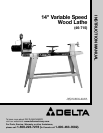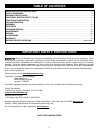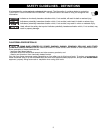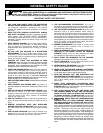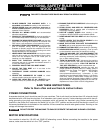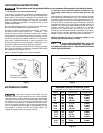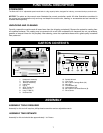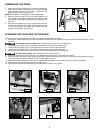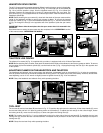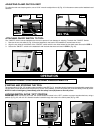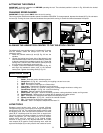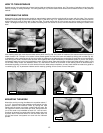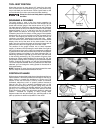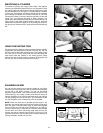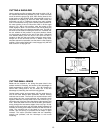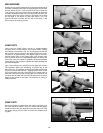
5
ADDITIONAL SAFETY RULES FOR
WOOD LATHES
1. DO NOT OPERATE THIS MACHINE UNTIL it is
assembled and installed according to the instructions.
2. OBTAIN ADVICE from your supervisor, instructor, or
another qualified person if you are not familiar with the
operation of this machine.
3. FOLLOW ALL WIRING CODES and recommended
electrical connections.
4. ROUGH CUT THE WORKPIECE as close as possible to
the finished shape before installing it on the faceplate.
5. EXAMINE THE WORKPIECE FOR FLAWS and test glue
joints before mounting the workpiece on machine. DO
NOT mount a split workpiece or one containing a knot.
6. SECURELY FASTEN THE WORKPIECE to the faceplate
prior to faceplate turning. Use the appropriate size
faceplate to properly support the workpiece. Do not let
the screw fasteners interfere with the turning tool at the
finished dimension of the workpiece.
7. NEVER DRIVE THE WORKPIECE into the drive center
while the drive center is in the headstock. Set the drive
center into the workpiece with a soft mallet prior to
installing it on the headstock.
8. SNUG THE TAILSTOCK CENTER against the
workpiece and lock it. Lubricate the tailstock center if it
is not a ball bearing center.
9. PROPERLY ADJUST THE TOOL REST HEIGHT.
10. ADJUST THE TOOL REST so it is as close to the
workpiece as possible.
11. TIGHTEN ALL CLAMP LOCKING HANDLES before
operating.
12. ROTATE THE WORKPIECE BY HAND to check
clearance before turning the machine “ON”.
13. CLEAR THE LATHE BED OF ALL OBJECTS (tools,
scraps of wood, etc.) before turning the machine “ON”.
14. EXAMINE THE SET-UP CAREFULLY before turning the
machine “ON”.
15. STAND CLEAR, AND KEEP ALL OBSERVERS AND
PASSERSBY clear of rotating path of workpiece to
avoid injury from flying debris.
16. USE THE LOWEST SPEED when starting a new
workpiece. NEVER EXCEED recommended speeds.
17. NEVER ADJUST THE TOOL REST while the workpiece is
turning.
18. NEVER LOOSEN THE TAILSTOCK SPINDLE or the
tailstock while workpiece is turning.
19. MOVE THE CUTTING TOOL INTO THE WORKPIECE
SLOWLY, and cut small amounts when roughing.
20. REMOVE THE TOOL REST before sanding or polishing.
21. NEVER PERFORM LAYOUT, assembly, or set-up work
on the table/work area when the machine is running.
22. TURN THE MACHINE “OFF” AND DISCONNECT THE
MACHINE from the power source before installing or
removing accessories, before adjusting or changing set-
ups, or when making repairs.
23. TURN THE MACHINE “OFF”, disconnect the machine
from the power source, and clean the table/work area
before leaving the machine. LOCK THE SWITCH IN
THE “OFF” POSITION to prevent unauthorized use.
24. ADDITIONAL INFORMATION regarding the safe and
proper operation of power tools (i.e. a safety video) is
available from the Power Tool Institute, 1300 Sumner
Avenue, Cleveland, OH 44115-2851
(www.powertoolinstitute.com). Information is also
available from the National Safety Council, 1121 Spring
Lake Drive, Itasca, IL 60143-3201. Please refer to the
American National Standards Institute ANSI 01.1 Safety
Requirements for Woodworking Machines and the U.S.
Department of Labor OSHA 1910.213 Regulations.
SAVE THESE INSTRUCTIONS.
Refer to them often and use them to instruct others.
FAILURE TO FOLLOW THESE RULES MAY RESULT IN SERIOUS INJURY.
A separate electrical circuit should be used for your machines. This circuit should not be less than #12 wire and should
be protected with a 20 Amp time lag fuse. If an extension cord is used, use only 3-wire extension cords which have 3-
prong grounding type plugs and matching receptacle which will accept the machine’s plug. Before connecting the
machine to the power line, make sure the switch (s) is in the “OFF” position and be sure that the electric current is of
the same characteristics as indicated on the machine. All line connections should make good contact. Running on low
voltage will damage the machine.
DO NOT EXPOSE THE MACHINE TO RAIN OR OPERATE THE MACHINE IN DAMP LOCATIONS.
POWER CONNECTIONS
MOTOR SPECIFICATIONS
Your machine is wired for 110-120 volt, 50/60 HZ alternating current. Before connecting the machine to the power
source, make sure the switch is in the “OFF” position.



